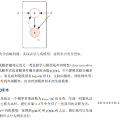We deal with Bayesian generative and discriminative classifiers. Given a model distribution $p(x, y)$, with the observation $y$ and the target $x$, one computes generative classifiers by firstly considering $p(x, y)$ and then using the Bayes rule to calculate $p(x | y)$. A discriminative model is directly given by $p(x | y)$, which is used to compute discriminative classifiers. However, recent works showed that the Bayesian Maximum Posterior classifier defined from the Naive Bayes (NB) or Hidden Markov Chain (HMC), both generative models, can also match the discriminative classifier definition. Thus, there are situations in which dividing classifiers into "generative" and "discriminative" is somewhat misleading. Indeed, such a distinction is rather related to the way of computing classifiers, not to the classifiers themselves. We present a general theoretical result specifying how a generative classifier induced from a generative model can also be computed in a discriminative way from the same model. Examples of NB and HMC are found again as particular cases, and we apply the general result to two original extensions of NB, and two extensions of HMC, one of which being original. Finally, we shortly illustrate the interest of the new discriminative way of computing classifiers in the Natural Language Processing (NLP) framework.
翻译:我们处理的是Bayesian 基因化和歧视性分类。 根据模型分配 $p(x, y), 观察 $y(x, y) 和 目标 $x(x, y), 一个人首先考虑 $p(x, y),然后使用 Bayes 规则来计算 $p(x, ⁇ y) 美元。 一种歧视模式直接由 $p(x, x, y) 提供, 用来计算歧视分类者。 然而, 最近的工作表明, 由 Naive Bayes (NB) 或 隐藏 Markov 链 (HMC) 所定义的Bayesian 最大分级( $y, $y, y, y, y, y, y, y, y, y, y, y, y, y, y, y, y, y, y, y, y, y, y, y, y, y, y, y, y, y, y, y, y, y, p, y, y, y, y, y, y, y, y, y, y, y, y, y, y, y, y, y, y, y, y, y, y, y, y, y, y, y, y, y, y, y, y, y, y, y, y, y, y, y, y, y, y, y, y, y, y, y, y, y, y, y, y, y, y, y, y, y, y, y, y, y, y, y, y, y, y, y, y, y, y, y, y, y, y, y, y, y, y, y, y,




